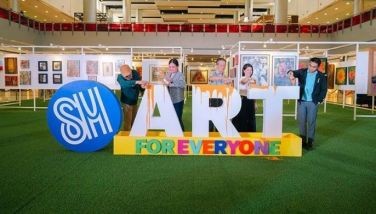Because love bullets revolution
Last week I texted family, friends and colleagues, asking them to translate this Tagalog phrase: “Dahil Rebolusyon ang Bala ng Pag-Ibig.”
Here are some 13 from around 30 translations I received:
Because revolution is the bullet of love.
Agnes Arellano, sculptor and founder, Pinaglabanan Galleries
Conrado Banal, business editor, Philippine Daily Inquirer
Ringo Bunoan, artist and co-founder, Big Sky Mind Artist Foundation
Melvin Mojica, fashion show director
Yodel Pe, creative director, Manila Envelope
Gani Simpliciano, bassist, Loss Of Control
Alexis Tioseco, film critic
Galileo Zafra, director, UP Sentro ng Wikang Filipino
Love’s shell is revolution.
Jed Escueta, photographer
Because love’s bullet is (a) revolution.
Neil Garcia, poet and scholar
The weapon of love is revolution.
Corinne Ching, designer and founder of I Love You store
Because revolution propels love.
Eileen Legaspi-Ramirez, curator,
As the revolutionary is love’s bullet.
Marc Gaba, poet
Because revolution is the bullet that loads the gun of love/ because love is the bullet that loads the gun of revolution.
Padma Perez, anthropologist
Isang pakikibaka ang pag-ibig. One continues the struggle when one loves.
Stephanie Cabigao, student, Malikhaing Pagsulat sa Filipino
Love is the blood of destruction.
Kiko Escora, artist and DJ, Fluxxe
The soundness in love lies in revolution.
Anne De Guzman, director, UP Film Institute
Is this a joke?
Paula Guinto, teacher
Lena Cobangbang, artist
Sorry, it doesn’t mean anything to me at this time.
My brother
Literal translation does not seem to make much sense and hence difficult to explain.
My father
* * *
CONDEMNED
Howie Severino’s I-Witness documentary
(
The Macapagal Tenement Building in Tondo has been condemned for over 15 years, yet is still the crowded home of over 1,000 families, including the poorest of the poor, some criminals and a handful of artists.
Built during the administration of President Diosdado Macapagal as a showcase for government concern for the urban poor, it is now a wretched symbol for what has gone wrong in the country since.
When night falls, the hallways are filled with a frightening darkness and countless hazards, from lurking criminals to concrete dropping from the ceilings. A balete tree grows eerily from the side of the building, its roots extending six stories to the ground. Teenage rappers share dark visions of Tondo’s brutality.
Howie Severino and his documentary team immerse themselves in the buildings’ dark, dirty and dangerous catacombs... and discover a brighter side. Artists on nearly every floor are painting murals to enliven their neighborhood, old-timers are full of tales of the building’s glorious past, and most residents believe the concrete building protects them from the elements rather than endangers them.
* * *
Gaston Damag, Damien Deroubaix, Manuel Ocampo
The usual press release may not serve the purpose for the exhibit which Gaston Damag, Damien Deroubaix and Manuel Ocampo opened at the Mag:net on July 7. Words can only complicate and deviate from the veneer of the layered surfaces. Greil Marcus’ seminal book Lipstick Traces : The Secret History of the Twentieth Century seem to forecast the motives and/or raison d’être of their unaesthetic and difficult decisions deliberated through their works, despite coming from different ends, different systems, different teleologies, as though we are all as guilty as shoplifting from the dustbin:
“What remains irreducible about (art or the hell everyone’s been doing) is its desire to change the world. The desire is patent and simple, but it inscribes a story that is infinitely complex — as complex as the interplay of the everyday gestures that describe the way the world already works. The desire begins with the demand to live not as an object but as a subject of history — to live as if something actually depended on one’s actions — and that demand opens onto a free street (and consequently to the free market as well). Damning God and the state, work and leisure, home and family, sex and play, the audience and itself, (art makes it possible) to experience all those things as if they were not natural facts but ideological constructs: things that had been made and therefore could be altered, or done away with altogether. It became possible to see those things as bad jokes, and for the (art) to come forth as a better joke. The (art) came forth as a no that became a yes, then a no again, then again a yes: nothing is true except our conviction that the world we are asked to accept is false. If nothing was true, everything was possible...”
* * *
Dance Forum and Wi-fi Dance Festival
Dear Yason,
It is 10 years since the opening of “Star Maiden,” that first full-length solo which opened my studio as an alternative performing space. I lived “Star Maiden.” Alone, seemingly pushing a big rock up a mountain or placing a stone one in front of another to step into a sea of nothingness, it nevertheless gave me the spirit which brought me up to the clouds in a carpet of white roses. I belonged — a Filipino, child of a farmer and a star maiden. No one predicted that the “fragile circle” of artists vortexing around me would eventually be this entire community of independent contem-porary dance in the
—
Ten years back, Dance Forum opened its studio as an alternative performing space and independent dance has not looked back since.
Wi-fi Body is a dynamic exchange of ideas between local and international artists, and searching for dance’s unique voice in a fast-changing world. Thirteen new and emerging choreographers, among them, Nina Hayuma Habulan, Stephen Biadoma, Patrick John Rebullida, Robbie Hayden, Rudolph Segundo, Carlon Matobato, Horhe Amparado, Chris Nocon, Ava Maureen Villanueva, Jethro Pioquinto, Oliver Palad, Herbert Alvarez and Jeremy de la Cruz, create personal statements of their choreographic vision in the solo/duet form as they vie for top awards in the New Choreographers Competition.
* * *
Translation: Few Eyewitnesses. Many Possibilities. New Movements.
- Latest
- Trending





























